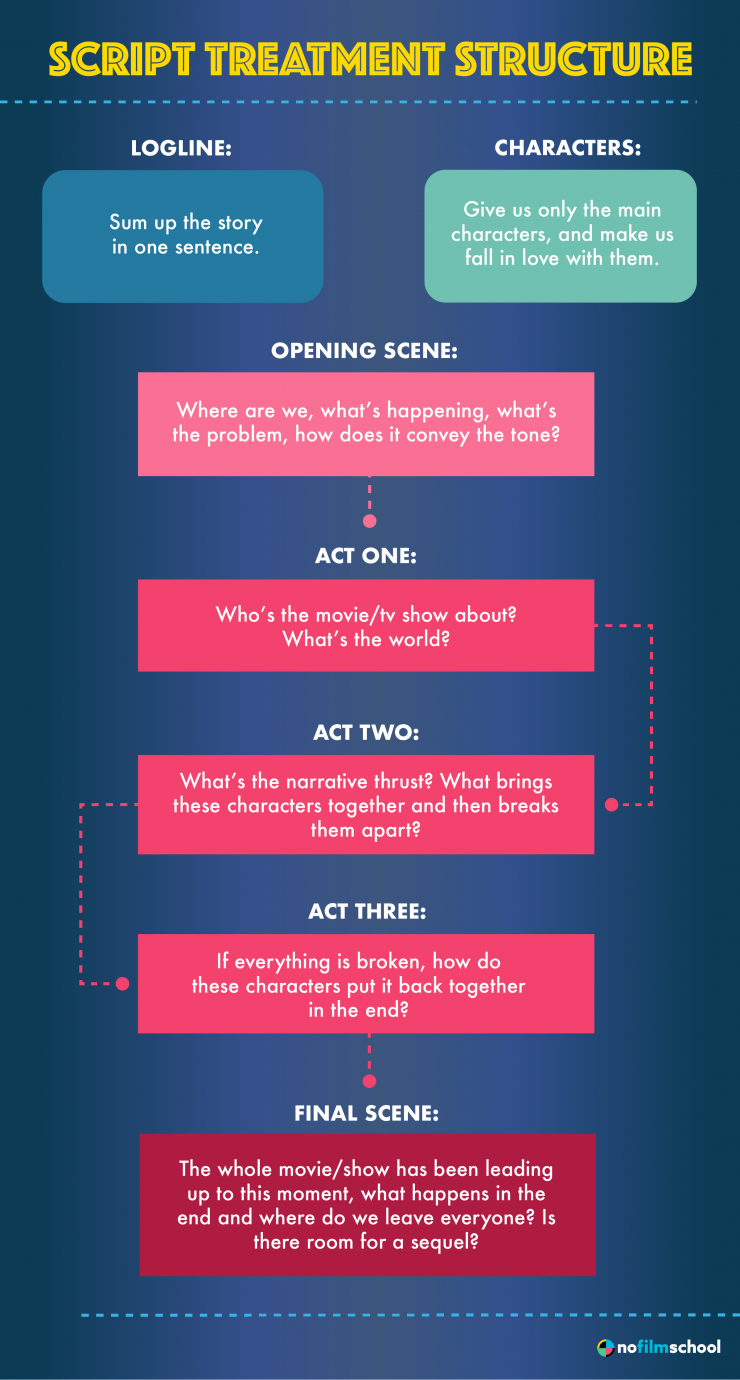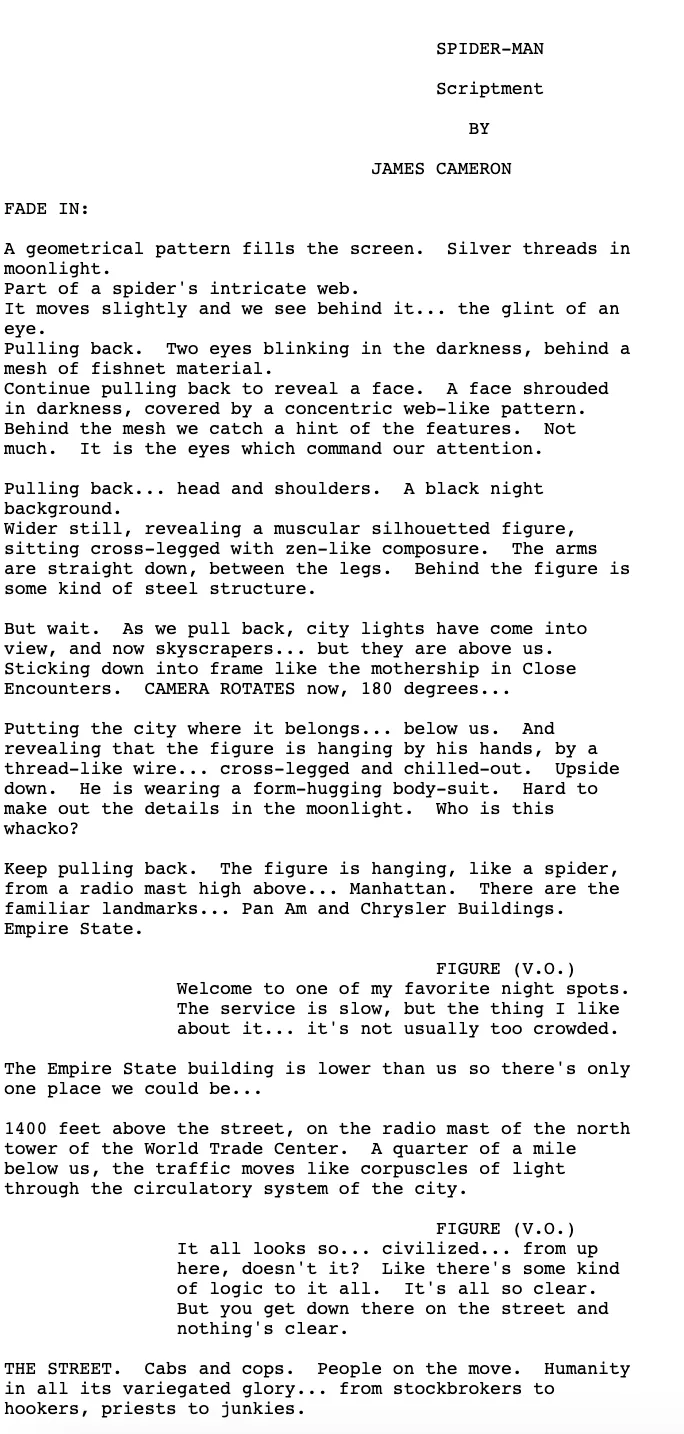
Start to streamline your writing process with a film script treatment.
Tell me if this sounds familiar to you... You just got out of a great general meeting, and the executive you met with loves your latest idea. You want to develop it together, and that's the first step towards your vision, finding its way to the screen. You're maybe considering writing this on spec, but you have to pump the brakes because you need something first.
Before you even write that movie script, which we can help you with here, you need to get all these great ideas down onto the page...that something is… a script treatment for your film.
Where do you begin to write? I find the best course of action is to start with a script treatment. And what if you don't know how to write a treatment for a movie?!
What's a Shooting Script? Find Out Here!
What’s a script treatment, screenplay treatment or film treatment (we’ll use those terms interchangeably)? And more importantly, how can you write one that helps seal the deal, or even sells the movie?
Watch This Video on Writing Treatments
In this post, I'm not only going to show you how to write an amazing treatment that will aid in the development process, but how that treatment process can also be super useful to you when you sit down to write the screenplay itself.
Table of Contents
Let's learn how to write a treatment!
The Film treatment basics
What is a film treatment, and how do you write one?
It's a multi-page document written in prose, that tells the story that happens in your screenplay. It is a synopsis, with action, sparse dialogue, and works as a roadmap for the reader, producer, and writer.
This is your story, broken down into an easy-to-follow document, that anyone who picks it up can grasp immediately.
And get excited about.
This document must be engaging to any agent, assistant, executive, or layperson on the street. Your screenplay treatment will only shine with hard work.
Why do you need a script treatment for your film?
Screenwriters find treatments are beneficial when it comes to shopping the work around town.
They’re also great for hashing out ideas before entering a draft, and to see if that kernel of inspiration is worth pursuing as your next project.
Another thing I love about them?
They do a lot of the heavy lifting when you’re trying to figure out your movie or TV show’s tone.
It’s your chance to be snarky, emotional, and nail the world of your story before you even open your screenwriting software.
It’s like a dry-run. And it can be fun to do it, too.
Let’s be honest; it’s hard to pitch your idea out-loud to people. A script treatment gets all the details out on the page and entertainingly spins them into a yarn worth retelling.
If you can get the treatment down, the pitch is a lot easier.
What Are Script Readers Looking For?
How long should a script treatment be?
While a script can be 80-120 pages, your treatment’s length will vary.
When I write mine, I usually try to keep them around 10-12 pages. I include act breaks, opener, and closing scene.
But some people do a real quick version all on one page.
If I'm making one for a TV show, it might skew longer. But you don’t want to confuse a script treatment with a show bible, or even a pitch deck. This treatment should cover the pilot and probably will become a section in the bible.
Lots of people don’t add dialogue to their treatments, but sometimes I’ll add one or two lines to evoke emotions or even some jokes.
You certainly don’t want to go overboard on the dialogue here. The dialogue will likely change, and you don’t want someone to bump on the idea because the lines you include don't radiate off the page.
Still, there are no definitive rules about how you do this, so make rules that work for you.
This is your chance to convey your story the best way possible. Maybe that means outlining characters, spending time on paragraphs describing the world, or even just giving a state of the union on why you NEED to write this movie.
Let this synopsis speak for you and spark more ideas.
Sample screenplay treatment
This is the outline I use when I start this process. It’s not perfect, but it prompts me and starts getting me going.
Use it as a leaping off point and customize it for your needs.
So without further ado, check out our film treatment template.

Put your voice into this film treatment sample!
Logline: Sum up the story in one sentence.
Characters: Give us only the main characters, and make us fall in love with them.
Opening Scene: Where are we? What’s happening? How does it convey the tone?
Act One: Who’s the movie/tv show? What’s the world?
Act Two: What’s the narrative thrust? What brings these characters together and then breaks them apart?
Act Three: If everything is broken, how do these characters put it back together in the end?
Final Scene: The whole movie/show has been leading up to this moment, what happens in the end, and where do we leave everyone? Is there room for a sequel?
I take all these headings and expand upon them.
You want the experience of reading this to be similar to that of watching the movie. It should have all the eventual favorite scenes that will be a blast to write.
It should take you through all the big emotions.
Let’s look at two successful writers and see what they have to offer on the subject,
Film script treatment samples and examples
Even the greats write treatments for their projects. So I figured it would help to include some examples by the pros.
You'll quickly see that these come in all shapes and sizes. One of the ones I love checking out is from the unmade James Cameron’s Spiderman.
Check out how he evokes the tone and story while also keeping it playful. You’ll also see that he loves to use dialogue too.

Turns out, this James Cameron guy is a pretty good writer, especially in this film treatment sample.
But let’s take a look at a more traditional example from the screenwriter, John August. This is his treatment for a TV show called “The Circle.”
This is opening page:

Right off the bat, you can see that August’s approach is entirely different from Cameron. He’s much more concerned about building out the logic of the world and how the show will function.
Again, neither example right or wrong; they are just two different approaches given the subject matter.
So now that I have a treatment, what’s next?
I know I got you excited in the opening about development executives loving treatments, but there are a few things you have to come to terms with... the first being that treatments don’t usually sell.
Once in a while, someone will option an idea based on the treatment.
But that rarely happens. Which leads us to an important question…
Why write these in the first place?
I find them to be the first place where I can see if a story can sustain 90 minutes, or if a TV show has what it takes for me to write the pilot.
Treatments are where I explore ideas in greater depth. It’s where I feel free to make mistakes, to find out what happens in Act II, and to nail my opening and closing scenes.
After I’m satisfied with my pass, I usually give them to my manager so he can get a sense of my latest project.
After I get my manager’s feedback, I either start writing, or I share with some executives who might have been interested in the idea.
As you know, the best reason to write a script after the treatment process is that someone is paying you to do it!
Treatments rarely get you paid, but it’s good to try!
Also, as we said it's a great place to explore your idea and get people excited.
A-list screenwriter Terry Rossio has an entire blog post that dispels the commercial viability of a movie treatment, but also asserts why they’re so important to his process.
“You will write reams of treatments in your stay in Hollywood. And not a single word of any of them will be of any value to anyone. And still, you'll have to do them anyway. I know that doesn't make sense. It never will. As I said, these days, short of understanding, we just go for truth.”
Rossio goes on to say…
“And while the treatments themselves might not have much value, there is value in the act of writing them. It's all about reassurance. And building a relationship with the executive. They're in a tough place -- having to gamble on a writer, and waiting months to see if the gamble pays off. A treatment gives them some bit of hope, a scrap of paper to put into their file, something tangible to hold onto. And I suppose treatments do offer some small insurance, to all involved -- if the writer is way, way off, it's probably better to know that sooner than later. In theory, the best case scenario, a treatment can allow you to 'skip a draft' and fix story problems without having to execute them in detailed screenplay form.”
This can all seem disheartening, but I think the positive to take away from here is how Rossio uses the process to learn and discover.
Writing is so damn hard.
You are literally creating something out of nothing. So you can do yourselves this one favor.
Before you open that screenwriting software, try clearing all your hurdles in this earlier stage.
Remember, never write a treatment for free
Free work is the bane of all writer's existence. If you don't know how to turn down the offer or suggestion that you do free work the WGA has you covered check out this video:
Video is no longer available: www.youtube.com/watch?time_continue=2&v=_GhZMFTtags
That said, the treatment process is still an excellent tool for your writing. There are also plenty of places that will compensate you fairly for that work.
Wrapping up script treatments
A treatment is a great way to organize your thoughts about a project. While they may not be the most commercially viable things, they’re great ways to get on a development executive’s good sides and to see if your idea is worthwhile in the marketplace. They can also help you with agents and managers (check out our complete guide on representation here).
This is also your first line of defense against writer’s block, and it's a "wonder tool" to get your intentions on the page. Hopefully, the movie treatment helps you.
If you have other sections you use in your treatments, or have specific treatments you love, let us know in the comments!
Up next? Get screenwriting tips from greats like Christopher Nolan, and Taika Waititi.
Your Comment
10 Comments
Great pointers, great thoughts I appreciate your insight, it helped me out a lot.
April 9, 2019 at 4:07AM
Very interesting opinion, thank you for sharing!
April 9, 2019 at 6:59AM
Thanks for all these helpful tools for writing my first-ever script! Greetings from the Netherlands
August 8, 2019 at 3:04AM
My favorite part is "Why write these in the first place?" It's great insight.
September 19, 2019 at 5:53AM
Nice Explained One!
December 10, 2019 at 12:19AM
I have to say, both of your examples above are atrocious. Of all the film treatments and writers in the world, why would you give an example of a "scriptment" from James Cameron for a movie that hasn't even been made? How does this help your reader? A scriptment is something Cameron created for himself and includes content that doesn't belong in a film treatment, instead primarily being reserved for the script itself (dialog, camera direction, etc.) So if I were to explain to someone what a TREATMENT is, I certainly wouldn't cite anything from Cameron, especially a movie that hasn't even been made. How are you supposed to show the reader how a real movie is translated into a treatment if they can't watch the movie it's referencing? It would be nice to show the contrasts between the final product and its inception, but whatever. The second example is awful. A treatment should describe what can be seen on screen. It's why it doesn't typically include dialog unless it's crucial to the plot. That "treatment" is so full of exposition and glib commentary, I couldn't imagine a single reader getting past the first page without tossing it in the bin.
I don't know what game you're playing at, "nofilmschool.com" but as someone who DID attend a film school and currently works in the industry, I wouldn't recommend this article to any young writer starting out.
March 1, 2020 at 6:09AM
Start to streamline your writing process with a film script treatment.
July 19, 2020 at 8:15PM
Hi from Austin, Texas! I'm confused. The WGA video says don't do beat sheets, outlines, notes, nothing in writing, and keep conversation verbal with producers as it flies in the face of what's fair to the writer and what's right for the WGA.
However, your entire web page is about writing a treatment. I get that this is a tool mostly for the writer to organize his/her thoughts so as to not wander through a potential screenplay ad infinitum with a small nod to giving the executive a sneak peek in to your idea and to see it blossom along the way.
My treatment is "1900: The Year of Revelations". The story has lots of chops with a major epic disaster looming at the end. I was gong the historic fiction novel route via an initial short story which smells like a film treatment. Thinking of morphing from novel to film which is the story best and highest use. Also, I think in cinematic terms while I am a damn good prose writer. I also have decades in the entertainment industry so I know the vibe of it all and have a very strong sense of great stories and what makes an audience sit up and bark!
Any additional thoughts would be greatly appreciated to clarify all this.
I also don't understand this sentence, below:
"There are also plenty of places that will compensate you fairly for that work."
Where are those places. I'm not a WGA member - yet
Thanks for your time and for this fine resource. John Bernardoni
July 30, 2020 at 1:08PM
Excellent text, all in detail and clear.
November 9, 2020 at 6:03AM
GREAT ARTICLE, thank you .
December 7, 2020 at 3:35AM